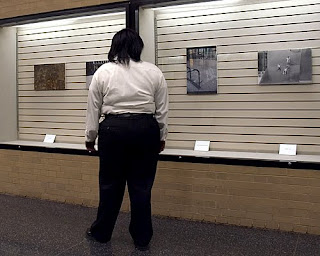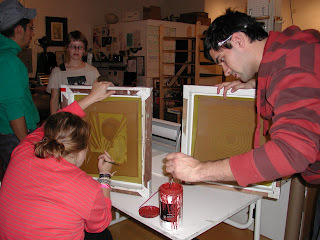Jennifer Geigel Mikulay
Ph.D. in Visual Culture
Professor at Alverno College,
Milwaukee, WI
How do the streets of Chicago function as a studio? What may spring immediately to mind is the city’s fantastic heritage of public murals, architectural ornament, monumental sculpture, seasonal festivals, and frequent displays of what curator Mary Jane Jacob calls “culture in action.” Yet, most of these works arrive on the street only after prolonged periods of trial and error, incubation, dreaming, and planning, activities associated with the studio. Chicago’s most beloved works of public art—such as the downtown sculptures of Abakanowicz, Calder, Kapoor, Picasso, or Plensa, for example—were imagined in studios far from their ultimate siting.
The relationship between public art and the studio seems somewhat unidirectional: artists envision and make their work away from public view and then present it as a final production. Though work may be inspired by the activity of the street, most public art is not actually planned, refined, or made there. In fact, many artists do not find a need to engage local publics directly in the creation of public artworks.
The relationship between public art and the studio seems somewhat unidirectional: artists envision and make their work away from public view and then present it as a final production. Though work may be inspired by the activity of the street, most public art is not actually planned, refined, or made there. In fact, many artists do not find a need to engage local publics directly in the creation of public artworks.
Reception of public art is a different story. Response—a creative and critical process in its own right—begins on the street in the direct encounter between artwork and viewer. Could there be value in conceptualizing this space of openness and response itself as a studio? In the shadow of an outdoor sculpture, how do viewers imagine the range of possibilities for that work? How do these ideas emerge, find expression, change, and develop over time? Is the street an extension of the studio, rather than its opposite? If so, what does it mean to extend the domain of the studio to non-artists?
I recognized public art’s ability to convert the street to a studio in 2005 when Chicago photographers organized a protest of restrictive policies in Millennium Park by encouraging anyone and everyone to post images of Anish Kapoor’s Cloud Gate on Flickr. The sculpture’s reflective surface and highly accessible location instantly made it an appealing subject for photographers, but civic powers initially tried to control representation of the work. Within a matter of weeks, many thousands of images were shared on the web creating sufficient popular pressure to relax restrictions on photographing the work. Another key moment of recognition occurred when I participated in Milwaukee artist Paul Druecke’s 2006 project, A Public Space. Druecke challenged two dozen people from all walks of life to produce an image of Daley Plaza, and then he arranged an exhibition in the tunnel running beneath the plaza. Participating photographers looked at the monumental Picasso that is the plaza’s focal point, but they also looked away from it to turn attention on myriad activities also animating the site. Dan Wang’s catalog essay for the exhibition notes, “When viewing these images we must ask ourselves, What, exactly, is this space?”
Across any sculpture’s lifespan, public interaction stages surprising, unanticipated events. But, until recently, these responsive interactions were largely ephemeral or only recognized in private. The proliferation of mobile web-enabled devices in an increasingly digital culture facilitates greater awareness of what people actually make from their encounters with public art. The ubiquity of cell phones turns everyone into a photographer. Add Wi-Fi, and everyone is a publisher. Everyday life becomes a studio where anyone may produce images and texts expressing their experiences and observations. The production of these images and texts is creative activity, and the products themselves are artifacts of a sort of studio of the street.
Jennifer Geigel Mikulay is a Milwaukee-based public art researcher. She holds a Ph.D. in visual culture from the University of Wisconsin-Madison. She recently joined the faculty at Alverno College. For more information visit www.mikulay.org.
Photo Captions/Credits:
Cloud Gate by Anish Kapoor. Cloud Gate on a Cloudy Day photo by Anca Mosoiu. Accessed via Flickr.com (ancawonka’s photostream).
A Public Space: Daley Plaza 2006, a project by Paul Druecke. Installation view, Pedestrian Tunnel connecting Daley Center, Subway, and City Hall. Photo courtesy of artist.

























